Workplace communication statistics show that 86% of employees and executives cite the lack of effective collaboration and communication as the main causes of workplace failures.
On the other hand, teams who communicate effectively may increase their productivity by as much as 25%.
But, that only applies to those who have established effective channels of communication. Unfortunately, a third of communicators claim to be dissatisfied with the channels they use in the workplace in 2025.
So, what’s the solution to this communication conundrum? Surely, the answer lies in the newest workplace communication statistics we’re about to present.

- 64% of business leaders and 55% of knowledge workers believe that effective communication increases team productivity.
- 63% of people believe that wasted time is one of the worst consequences of poor communication.
- 57% of global employers indicate that communication is the most desirable skill for potential recruits to have.
- 55% of global recruiters believe that verbal communication is the most important communication skill job candidates should have, followed by presentation skills (47%), and active listening (36%).
- 36% of recruiters also indicated that knowing how to use digital communication tools and video conferencing is also a crucial skill for job candidates to possess.
- 89% of leaders and 52% of knowledge workers already use generative AI tools for work.
- 73% of knowledge workers say that gen AI tools have helped them avoid miscommunication at work.
Statistics on why effective communication is important in the workplace
Proper communication can benefit businesses in many ways.
Namely, effective team communication positively affects employees in terms of:
- Productivity,
- Engagement,
- Retention, and
- Trust.
So, what are the statistics on the importance of effective communication in the workplace? Let’s find out!
Benefit #1: Effective communication increases productivity
Arguably, one of the most important benefits of effective communication in the workplace is that it positively affects employee productivity.
In addition to feeling more connected to their colleagues, employees who regularly communicate with one another are more productive.
That much was evident in an older McKinsey report, which showed that well-connected teams see a productivity increase of 20–25%.
A more recent study from the McKinsey Institute about the future of remote work suggested something similar. Namely, employees who feel included in more detailed workplace communication are almost 5 times more likely to report increased productivity.
The most recent communication statistics we have on this subject comes from a report The State of Business Communication in 2024 conducted by the Harris Poll on behalf of Grammarly. That study showed that 64% of the 253 business leaders surveyed believed that effective communication has increased their team’s productivity, and 55% of knowledge workers agreed.
Additionally, 55% of the 1,002 surveyed knowledge workers claimed that effective communication increased their confidence at work. On top of that, 58% of workers also noted that it increased their job satisfaction.
However, we must acknowledge that unnecessary communication can also impair productivity, as Gallagher’s State of the Sector 2024 report points out. Specifically, too much communication can be a barrier to success, according to 19% of the participants of Gallagher’s survey. But, more on that later.
🎓 PUMBLE PRO TIP
Effective communication is arguably the only way to boost productivity in remote work settings. To learn more about what remote workers need to thrive, check out our remote work statistics:
Benefit #2: Effective communication improves engagement
According to Gallup’s State of the Global Workplace: 2024 Report, disengaged employees cost the world an unbelievable $8.9 trillion in lost productivity.
Though Gallup’s data showed some improvement, with employee engagement numbers going from 20% in 2020 to 23% in 2022, the percentage stagnated in 2023, at least in most global organizations.
Interestingly, the latest news from Gallup shows that employee engagement is on a slight decline in US-based companies (where engagement is now at 31%) as well as best-practice organizations (which boast 70% engagement rates), though those numbers are still better than the global average.
According to an overview of the key trends in employee engagement, it seems like this dip in engagement can be resolved by:
- Clarifying expectations (as only 46% of employees know what’s expected of them at work),
- Showing empathy and care (as only 39% of employees can claim that someone cares about them), and
- Focusing on employee development (as only 30% of employees have someone at work who encourages their development).
Unfortunately, it seems that not enough people in decision-making positions got the memo — even though a Gallup’s meta analysis report found that improving worker engagement would also increase productivity by 18% (in the sales sector) and profitability by 23%.
🎓 PUMBLE PRO TIP
If you’re interested in learning more facts about employee engagement, read the following article:
Benefit #3: Effective communication increases retention
The Great Resignation came and went, leaving much of the corporate world scrambling to fill empty cubicles.
According to Gallup’s latest report, this crisis is another result of poor employee engagement, as 62% of global workers are not engaged at work, which is a 3% increase compared to the previous year’s report.
A significantly lower number of workers, 23%, claimed to be engaged with their work and thus did not have plans to leave their job.
However, 15% of respondents also described themselves as being actively disengaged, which may directly impede their company’s goals.
The correlation between engagement and quiet (or loud) quitting has led Gallup’s researchers to conclude that having engaged workers reduces turnover by:
- 51% in low-turnover organizations, and
- 21% in high-turnover organizations.
Other sources also confirm this theory. For one, the Achievers Workforce Institute’s 2024 Employee Engagement and Retention report showed that 72% of surveyed employees would be more likely to stay at a job where they feel supported, cared for, and valued, than a job where they don’t feel valued but are paid 30% more.
What’s more, as many as 52% of global employees claimed to be actively looking for a new job at the time of Gallup’s most recent survey. Moreover, 54% of survey respondents even believed that then was a good time for job hunting, in general.
Since these numbers have remained more or less the same since the previous year’s survey, the situation will likely remain unchanged in 2025 as well.
Benefit #4: Effective communication facilitates trust
According to a report on trust in the workplace issued by the Workforce Institute at UKG, 74% of employees would prefer to work for a trustworthy employer.
Yet, according to the 2025 Edelman Trust Barometer, only 75% of employees around the world can confidently state that they trust their employer to do what’s right — a decline from the previous period’s 78%.
Moreover, low income workers seem to have a harder time with trusting their employers, as only 48% of them can claim to do so, as opposed to 61% of high income professionals.
Even though the problem is likely exacerbated by tax evasion and similar disreputable practices, dishonest communication seems to be at the heart of this issue.
After all, as many as 68% of survey respondents believe that business leaders purposely lie and exaggerate, as opposed to the 56% of respondents who agreed with that statement in 2021.
But, what does this have to do with you? Well, according to the Workforce Institute at UKG report on trust in the workplace:
- 68% of employees feel that low trust is detrimental to their daily effort and productivity,
- 24% left a company because they didn’t feel trusted by their employer, and
- 22% reported not making referrals due to a lack of trust in their company.
So, how can an organization build trust between employees and employers?
Well, practicing open and honest communication is certainly a step in the right direction. That includes training management to provide helpful feedback without having to be asked.
On top of that, simply caring about your employees can go a long way towards establishing trust, especially since that’s one of the pain points highlighted by Gallup’s recent report.
Statistics on the cost of poor communication at the workplace
We all know that miscommunication in the workplace can have serious repercussions for a business. But are there any numbers that corroborate those claims? What are the statistics on poor communication in the workplace?
Well, according to The State of Business Communication report, business leaders have noted 3 major consequences of ineffective communication at work:
- 40% of them claim that poor communication decreases productivity,
- 37% of the surveyed leaders claimed that having to extend timelines was the worst consequence of miscommunication, and
- 32% of business leaders have noticed the financial impact of poor communication.
Going forward, we’re going to look at workplace communication statistics that showcase the effects of poor communication strategies in 3 major areas:
- Burnout and (subsequent) decreased productivity,
- Professional failures, and
- Financial consequences for corporations.
Consequence #1: Poor communication leads to employee burnout and decreased productivity
According to the Grammarly-sponsored report The State of Business Communication, ineffective communication can increase stress and employee attrition — aka burnout.
This survey of knowledge workers showed that:
- 51% have admitted that poor communication has increased their overall stress levels,
- 41% noted a decrease in productivity due to poor communication,
- 35% have claimed that it has decreased their job satisfaction, and
- 31% have said that miscommunication has lowered their professional confidence.
The fact that stress and burnout are a major consequence of poor communication in the workplace has also been confirmed by Project.co’s Communication Statistics 2025, which showed that 43% of survey respondents have experienced burnout, stress, and fatigue due to workplace communication issues.
Yet, at this point, only 4 in 10 employees rate their employer as excellent or very good at helping employees improve their emotional, physical, and workplace wellbeing, according to the Employee Benefit Research Institute’s 2024 Workplace Wellness Survey.
The same report revealed that most employees who found their employers’ communication lacking did so in 3 specific areas:
- Flexibility and PTO for child/dependent care (22%),
- Mental health and work-life balance (18%), and
- Commitment to DEI programs (17%).
Figuring out a way to effectively address these concerns with your internal communication should let your employees know that you care about the same issues they care about.
🎓 PUMBLE PRO TIP
Recovering from burnout is difficult, but not impossible. For more information on the subject, check out this guide to burnout recovery:
Consequence #2: Poor communication leads to professional failures
Of course, the most obvious problems caused by poor communication have to do with professional failures.
According to a poll conducted by leadership development and training company Fierce, Inc., which surveyed over 1,400 employees, corporate executives, and educators, 86% of survey respondents believe ineffective communication is the underlying reason for workplace failures.
Namely, ineffective communication can lead people to misunderstand the scope of their professional responsibilities, which can, in turn, lead to failed projects and missed deadlines.
To offer a clearer picture, let’s take a look at the results of Project.co’s most recent survey:
- 63% of survey respondents have wasted time at work due to communication issues,
- 59% have missed messages,
- 31% have lost files,
- 24% report having a poor customer experience as a result of poor communication at work,
- 14% have lost customers to competitors due to miscommunication, and
- 8% have even lost employees.
Still, some of these issues can be solved by implementing a more effective communication solution.
For example, team communication apps like Pumble can prevent users from wasting precious time by promoting asynchronous communication.
If the messaging software you opt for has a simple, user-friendly design, you should be able to spot missed messages at a glance and have easy access to all your important files.
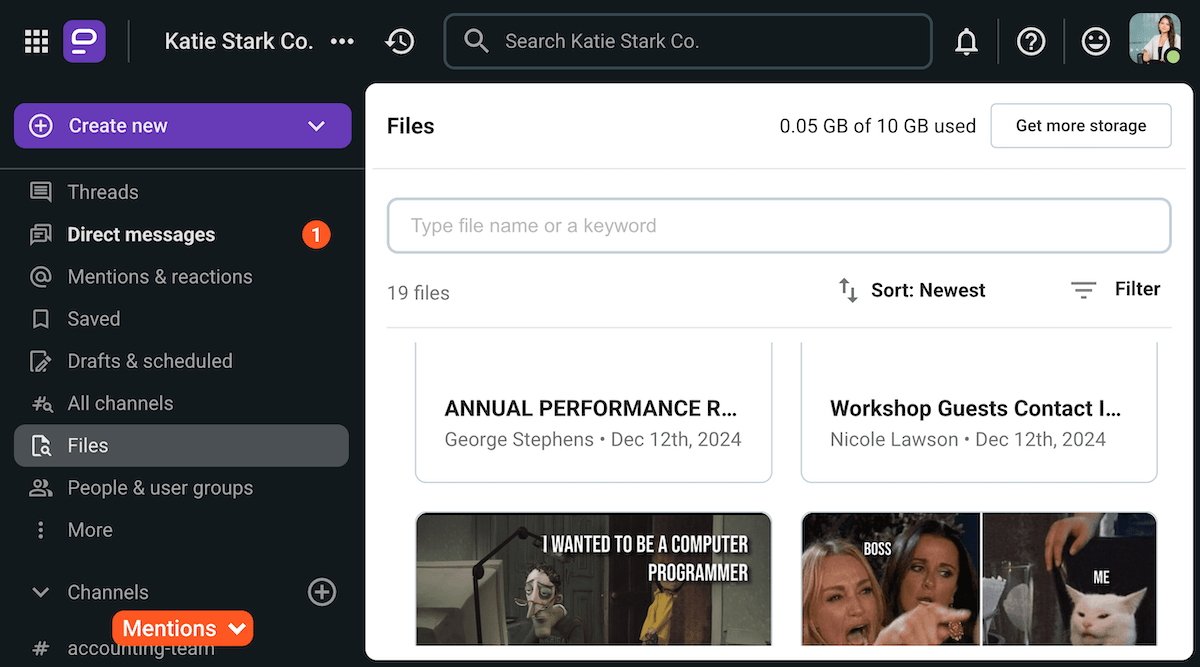
Never miss a message with Pumble
Consequence #3: Poor communication takes a financial toll on businesses
According to a recent report from Axios HQ, which surveyed over 1,000 employees, the cost of ineffective communication in the workplace amounts to anywhere between $10,000 and $55,000 per employee per year, depending on their annual salary.
Basically, these numbers highlight the fact that workers are spending hundreds of hours every year responding to unnecessary messages from coworkers and clients alike.
On a similar note, Grammarly’s most recent report mentioned that:
- 55% of professionals believe they spend too much time crafting and deciphering messages,
- 54% admit they find managing work communications challenging, and
- 53% feel anxious about the possibility of misinterpreting written messages.
On top of that, Project.co’s report confirmed that among customers who moved to a competitor in 2025, 68% report having done so due to the poor business communication skills of company representatives.
So, prioritizing effective communication on an organizational level can help you hang onto customers, clients, and employees alike.
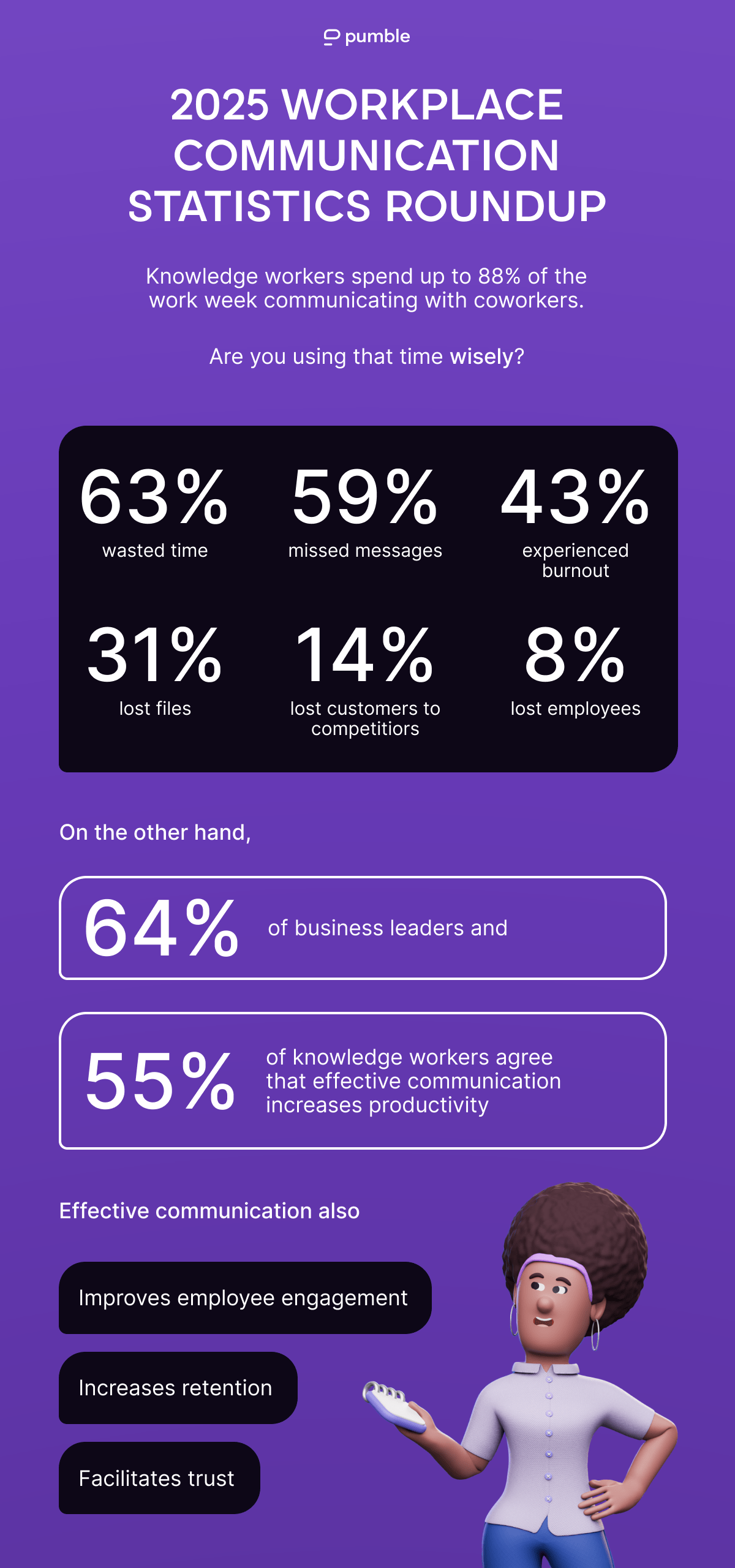
Statistics on the most used languages in business communication
Verbal and written communication are arguably the most important types of communication in the workplace — and beyond.
However, even these straightforward types of communication can be unsuccessful if the employees of a company don’t speak the same language.
In an increasingly multinational professional landscape, speaking a universal language has become a requirement.
Luckily, according to Duolingo’s most recent report, over 10% of the language learning app’s users report having picked up the English language course in order to boost their career.
Indeed, professional success seems to be one of the main motivations for new language learners in 2024.
With that in mind, let’s talk about the main languages you might want to add to your resume in 2025.
Business languages for international teams
According to one survey of virtual teams, participation in global teams grew from 64% in 2010 to 89% in 2018, with 62% of corporate employees having colleagues from 3 or more cultures in 2018.
Though these numbers are somewhat dated, they show the value of knowing at least 1 international business language.
But, which one should you learn if you want to set yourself up for success in 2025?
The table below shows the 10 most valuable business languages to know, based on the language’s Gross Domestic Product (GDP) in $US trillions and its share of the global GDP, based on the UN’s analysis of the GDP of various languages between the years of 2019 and 2021. We’ve also included the number of people who speak these languages worldwide, as reported by Ethnologue.
| Language | GDP in $US trillion | % of world GDP | Number of worldwide speakers |
|---|---|---|---|
| English | 23.94 | 27 | 1.5+ billion |
| Chinese | 16.54 | 18 | 1.1+ billion |
| Spanish | 6.99 | 8 | 559.1+ million |
| Japanese | 5.01 | 6 | 123.4+ million |
| German | 4.91 | 5 | 133.2+ million |
| French | 3.44 | 4 | 309.8+ million |
| Arabic | 2.43 | 3 | 274+ million |
| Italian | 2.18 | 2 | 67.9+ million |
| Portuguese | 1.95 | 2 | 263.6+ million |
| Korean | 1.86 | 2 | 81.7+ million |
Even though Russian and Hindi have dropped below the top 10, they remain crucial languages in the professional world, along with Dutch, Turkish, and Malay-Indonesian.
Interestingly, this list has a lot of overlap with the most popular languages studied on Duolingo in 2024, which include:
- English,
- Spanish,
- French,
- German,
- Japanese,
- Italian,
- Korean,
- Chinese,
- Portuguese, and
- Hindi.
Then again, different countries tend to prioritize other business languages.
Connect with your multinational team on Pumble!
Business languages in the US
Official statistics show that 78% of the US population only speak English. Even so, some might be surprised to learn that the United States doesn’t actually have an official language.
According to the most recent census data, many Americans also speak:
- Spanish,
- Chinese,
- Tagalog,
- Vietnamese, and
- Arabic — among other languages.
Furthermore, American students — the future of the US workforce — tend to favor Spanish when selecting a foreign language to learn.
A recent report issued by the Modern Language Association of America compared foreign language enrollments at institutions of higher education in the fall of 2021 to the results of their previous report, which reflected on the language enrollments during the summer and fall of 2016.
Ultimately, the new report found that language enrollment had dropped by 16.6%. Even so, the top 5 foreign languages for college and university students were similar to those highlighted in the previous report:
- Spanish — with a share of 49.42%,
- French — with a share of 11.42%,
- American Sign Language — with a share of 9.12%,
- Japanese — with a share of 5.55%, and
- German — with a share of 4.52%.
This focus on the Spanish language was also confirmed by Duolingo’s most recent report. Yet, interestingly, the same report showed that the second most popular course for US-based language learners was actually the English language course.
Business languages in the UK
According to the data from the 2021 census, 91.1% of the UK population speak English as their mother tongue. Unsurprisingly, the country’s official language is also English.
Still, the population survey showed that other than English (and Welsh, in Wales), people in the UK also speak:
- Polish — 1.1% of the population,
- Romanian — 0.8% of the population,
- Punjabi — 0.5% of the population, and
- Urdu — 0.5% of the population.
As for foreign language studies, a 2024 brief noted that most schools offer French, German, and Spanish classes — though the government doesn’t promote the teaching of languages in any particular way. As a result, only 32% of 15–30-year-olds in the UK report knowing 2 or more languages, compared to 80% of the population in EU member states.
Notably, this brief also mentioned the British Council’s report on the Languages for the Future, which showed that 18–30-year-olds in the UK did have some knowledge of other languages, namely:
- French,
- German,
- Spanish,
- Italian, and
- Hindi.
The document also listed 10 of the most important international business languages that are not English:
- Spanish,
- Mandarin,
- French,
- Arabic,
- German,
- Italian,
- Dutch,
- Portuguese,
- Japanese, and
- Russian.
In other words, these are the languages the UK population will need to learn to excel in increasingly multicultural and multilingual workplaces.
Luckily, according to Duolingo’s report, all signs indicate that UK-based language learners are taking this challenge seriously, as Spanish and French are the most popular courses on the app within the country.

Statistics on nonverbal communication in the workplace
Now, written and verbal communication are only 2 pieces of the larger puzzle that constitutes human communication.
With that in mind, we wanted to turn our attention to another piece that’s just as significant — nonverbal communication.
As the name suggests, this form of communication is about all the messages we send without using actual words.
In a professional environment, nonverbal communication can take many forms, relying on factors like:
- Appearance — e.g. our choice of business attire,
- Movement — e.g. the gestures a keynote speaker might use to project confidence,
- Facial expressions — e.g. the furrowing of a manager’s brow when showing disapproval,
- Vocal qualities — e.g. the pitch, volume, and inflection of someone delivering a presentation,
- Spatial positioning — e.g. the physical distance hinting at people’s attitudes toward one another,
- Physical touch — e.g. the firmness of someone’s handshake, and even
- Time — e.g. the speed with which someone responds to a message.
Going forward, we’re going to talk about the significance of this form of communication as it relates to the modern workplace through nonverbal communication statistics.
93% of communication is nonverbal?! The Mehrabian Myth
When the subject of nonverbal communication comes up, people often claim that 93% of all communication is nonverbal.
As an example, we can point to one author who stated that “nonverbal communication accounts for 93% of the impact of any given message.”
More often than not, though, this statistic is used to highlight the importance of projecting confidence during business presentations.
However, the research it stemmed from was never meant to be applied to that context.
As impressive as this would-be factoid sounds, it is a misconception that has been debunked so many times, it even has a name — the Mehrabian Myth.
By all accounts, this misconception stems from a misinterpretation of Albert Mehrabian’s 1967 research paper concerning the decoding of inconsistent messages.
In the study, Mehrabian and his coauthor, Morton Wiener, posited that, when faced with inconsistent messaging (for example, when someone says something that may not be entirely truthful), people usually look for the speaker’s:
- Body language (and facial expression) — at a rate of 55%, and
- Tone of voice — at an instance of 38%.
In other words, only 7% of the meaning the audience absorbs in instances of inconsistent messaging comes from the actual words the speaker used to convey their message.
So, that’s where the infamous 93% statistic comes from. Ultimately, it shouldn’t be used outside of the context it originated from.
Instead, we should look for studies that specifically deal with nonverbal communication in the workplace. But, do we have enough of those to reach a consensus?
The effects of nonverbal communication in the workplace
Unfortunately, there’s not much up-to-date research on the subject of nonverbal communication in the workplace. That omission was even mentioned in the Journal of Management in 2016, in a paper that suggested an agenda for further research in the field.
Sadly, the more recent studies on the subject are still somewhat lacking.
Take, for example, a 2020 study on the impact of nonverbal signals in business communication.
Researchers surveyed 150 people (an admittedly small sample size) and found that:
- 85% of them believed eye contact plays a vital role in business communication,
- 70% said that facial expressions (like smiling) impact business communication, though only
- 55% claimed to be able to accurately guess the emotions behind certain facial expressions.
Interestingly, only 25% of the respondents agreed with the prompt that physical appearance influences business communication.
However, the main takeaway of the study was that our professional exchanges are affected by factors pertaining to nonverbal communication, such as:
- A lack of knowledge of adaptive facial signals (according to 75% of respondents),
- Employers not understanding the potential of nonverbal signals (according to 70% of respondents)
- A lack of soft skills training (according to 65% of respondents),
- Cultural differences (according to 55% of respondents), and
- A lack of interpersonal communication (according to 40% of respondents).
As we can see, most of the survey participants found a lack of interpersonal communication to have the least impact on nonverbal communication in the workplace. However, we should remember the limitations of this study when looking at this data.
Barriers to nonverbal communication in the workplace
Though reports on the barriers to nonverbal communication are just as scarce as statistics on how we use nonverbal communication in the workplace, we’ve still managed to uncover some interesting numbers.
Owl Labs’ State of Hybrid Work 2024 report noted that having to conduct virtual meetings often results in workers missing beats in the conversation.
When asked to rate the frequency at which they were unable to see faces during meetings and thus ended up missing certain visual cues during conversations:
- 13% of workers said that this happened always,
- 23% said that it happened often,
- 34% said it happened sometimes, and only
- 30% of people said this never happened to them.
So, less than a third of remote and hybrid workers can claim to have never experienced this communication barrier.
Then again, going back to meeting in person presents a whole new set of challenges. For one, who would want to go back to the office after getting to work from home?
To answer that question, let’s take a look at the reason so many of us have gotten used to remote work by examining the impact the COVID-19 pandemic has had on the world of business communication.
🎓 PUMBLE PRO TIP
Not being able to see peoples’ faces on video calls is a big problem if you’re trying to practice nonverbal communication — but it’s not the only communication barrier you could experience during a meeting. For more statistics about communication in meetings, check out our meeting statistics article:
Statistics on workplace communication after COVID-19
Whether we like it or not, the COVID-19 pandemic has had a substantial impact on the global workplace.
Even after the pandemic started to wind down, many employees remained either fully remote or transitioned to a more hybrid work model.
According to Project.co’s most recent report, which surveyed over 350 professionals, the majority of people still work remotely in some capacity, with:
- 42% of survey respondents being fully remote,
- 19% spending an equal amount of time working remotely and in-office,
- 16% working entirely on-site,
- 12% working from home at least ¾ of the time, and
- 11% working on-site ¾ of the time.
However, these numbers may not be entirely applicable to the general public, as other reports may contain different statistics. According to Owl Labs’ State of Hybrid Work 2024 report, there may be as many as:
- 62% of people who are working from the office,
- 27% being hybrid, and
- 11% being fully remote workers.
In any case, the pandemic has certainly changed the way we work and introduced new remote work challenges for us to overcome.
Stay remote or return to the office: the deciding factors
Even though most workers are used to the “new normal” by now, Gallup’s most recent report noted that fully remote workers still experience higher levels of loneliness (25%) as opposed to hybrid workers (21%) and those who work exclusively on-site (16%).
On top of that, remote workers tend to feel sad more often, with 29% experiencing sadness the day before they were surveyed, as opposed to 21% of hybrid workers and 19% of on-site workers.
Still, this doesn’t seem to be affecting communication much, at least according to the numbers from the Communication Statistics 2025 report, which show that:
- 53% of people don’t find communication any more or less challenging than it was in 2024,
- 24% of people find communication less challenging than it was last year, and
- 23% find it more challenging than it used to be.
So, most people won’t be lured back into the office with the promise of better communication.
However, according to Owl Labs’ report, the promise of greater compensation might do the trick, according to 41% of employees.
The report also highlighted other issues that could influence employees’ decisions to go back:
- Commute times (28%) and costs (26%),
- Food and beverage costs (26%),
- Privacy and dress code concerns (23%),
- Better meeting room technology (18%), and
- The chance to see work friends (17%) and have onsite social events (16%) as potential deciding factors.
As indicated by the final 2 points above, some people don’t feel that the asynchronous communication tools provided by their organization are effective at providing a satisfactory experience for real-time communication.
Choosing a powerful and easy-to-use business communication platform like Pumble can improve in-office and work-from-home communication while bridging the gap between remote and on-site workers.
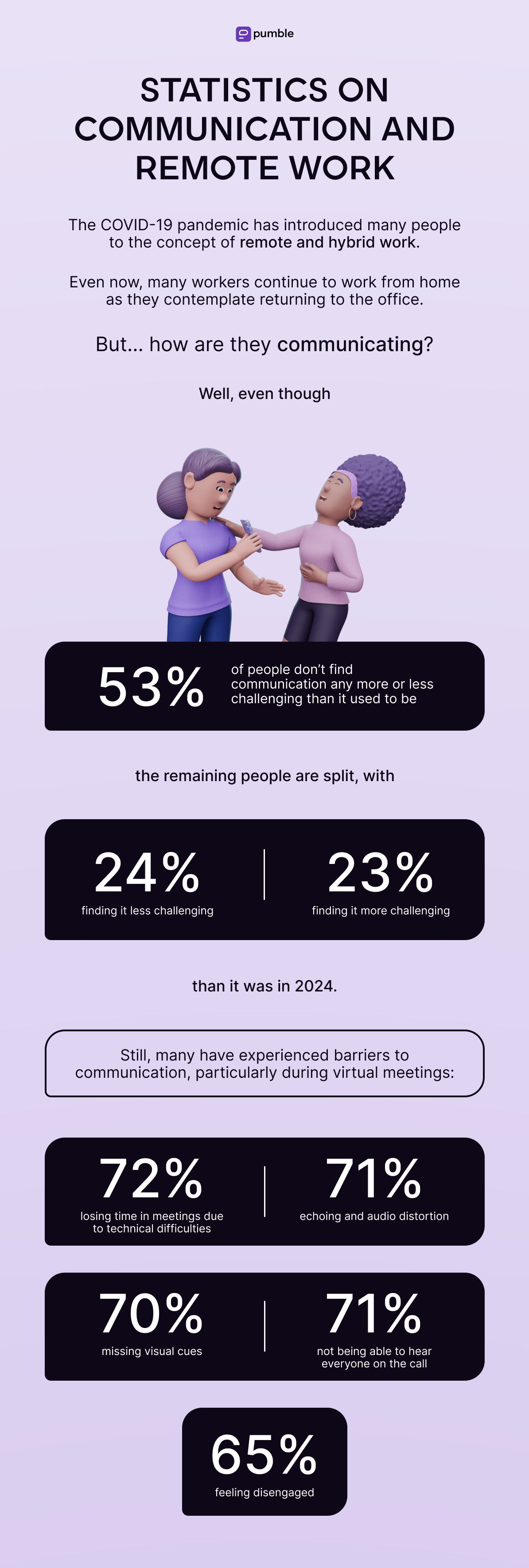
Statistics on how people prefer to communicate in the workplace
Workplace communication preferences depend on whether you are a manager or a regular employee.
Let’s see if the expectations of managers and employees align regarding what they want to gain from communication in the workplace.
Communication statistics on the most desirable communication skills in job candidates
According to the latest GMAC Corporate Recruiters Survey, 57% of global employers indicated that communication is the most desirable skill in potential recruits.
This source of communication skills statistics also included other related skills, prompted by:
- 50% of employers who prioritized interpersonal/teamwork skills,
- 42% of employers who highlighted emotional intelligence,
- 37% of employers who named networking and relationship building as a valuable skill, and
- 29% of employers who mentioned cross-cultural competence or cultural intelligence as an asset.
The same survey respondents ranked different communication skills in order of importance, resulting in the following list:
- 55% of employers prioritized verbal communication skills,
- 47% prioritized presentation skills,
- 36% mentioned active listening,
- 31% valued candidates with digital communication skills (the ability to effectively communicate via email or internal communication software),
- 30% appreciated candidates who could negotiate,
- 25% wanted candidates with great writing skills,
- 24% mentioned conflict resolution, and
- 20% highlighted cross-cultural communication.
Overall, the least valued communication skills among employers were:
- Multilingualism, which was valued by only 10% of respondents,
- Video conferencing skills (9%), and, interestingly,
- Nonverbal communication skills (8%).
Still, the exact skills employers value largely depend on the industry one wants to break into — so keep that in mind before you start neglecting your language studies.
Communication statistics on the purpose of internal workplace communication
According to Gallagher’s State of the Sector 2024 report, 84% of employees rely on managers for communication to some degree.
As such, managers, or “communicators,” as this report deems them, are responsible for:
- Employee engagement — according to 74% of survey respondents,
- Strategy awareness — according to 70% of respondents,
- Behavior change — according to 49% of people,
- Digital reach — according to 46% of respondents, and
- Policy compliance — according to 34% of people.
But, what do managers see as the purpose of internal communication?
Well, 78% of them would agree that culture and belonging are their priority, while 76% said that the purpose of internal communication is strategic alignment.
But, if alignment is the goal, leadership may be off the mark.
According to the latest report from Axios HQ, perceptions on the clarity and relevance of essential communications varied between leadership and employees, with:
- 85% of leaders stating that essential communications at their organization are helpful and relevant — which was seconded by only 45% of employees, and
- 83% of leaders claiming that this communication was also clear and engaging — though only 47% of employees agreed.
Moreover, the report also showed that most employees preferred getting updates on:
- Operational changes regarding process and policy updates,
- Organizational goals such as new initiatives and plans,
- People operations such as benefits or DEI initiatives,
- Culture and values,
- Business updates on projects, products, and clients,
- Personnel updates such as new hires or departures,
- Competitive insights and industry news, and
- World updates.
Yet, these employees were most frequently updated on the subjects they least cared to hear about — namely, industry news and world updates.
🎓 PUMBLE PRO TIP
If you find drafting messages for internal communication difficult, check out these resources:
Communication statistics on the importance of gathering employee feedback
One of the ways in which businesses can promote two-way communication internally is through giving and requesting feedback. But, that may be easier said than done.
According to the State of the Sector 2024 report, the most common ways of gathering employee feedback are:
- Engagement surveys (75%),
- Post-event feedback (54%),
- Live Q&A sessions (52%),
- Email (48%), and
- Pulse surveys (47%).
On the other hand, the report from Axios HQ showed that leaders tend to track internal communications mainly through:
- Employee surveys (41%),
- Unsolicited feedback from employees (39%), and
- Overall business performance (39%).
Interestingly, 22% of leaders also said that they used emoji reactions and comments to track their internal communication — so keep that in mind the next time you react to a company announcement.
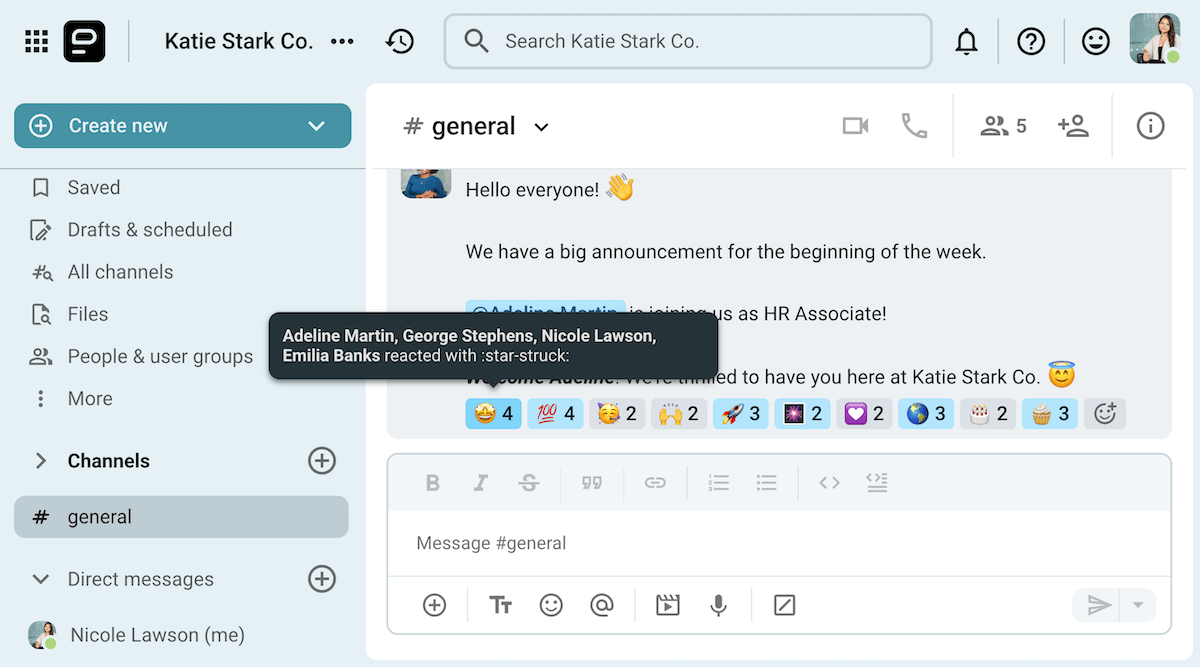
Share feedback seamlessly over Pumble
Despite all this apparent desire for employee feedback, the Axios HQ report also indicated that even though:
- 81% of leaders believe that their employees have an easy way to share feedback about internal communications, and only
- 44% of employees agreed.
Indeed, 36% of employees want more opportunities to provide feedback to leadership.
However, even if organizations open those channels of upward communication, knowing how to accept and apply the feedback in question would still be a matter.
After all, according to the Achievers Workforce Institute’s report on employee engagement and retention, people who say their employer takes meaningful action based on their feedback are 75% more likely to trust their company leadership than those who see their leadership gathering feedback but not acting on it.
🎓 PUMBLE PRO TIP
Feedback is an opportunity to improve. To learn more, check out this article:
Communication statistics on the effect of employee recognition on engagement, productivity, and retention
On the other side of the feedback coin, it should come as no surprise to learn that employees also like to be recognized for their contributions to the company.
In fact, people who are never recognized are 27% more likely than average to look for other jobs in 2024, according to the 2024 Engagement and Retention Report.
The same report also found that the frequency of recognition employees receive makes them more engaged and productive, and more likely to say that they rarely think about looking for other job opportunities, as shown in the table below.
| Frequency of recognition | Annual (or less frequent) recognition | Quarterly recognition | Monthly (or more frequent) recognition |
|---|---|---|---|
| Engagement | 27% | 34% | 51% |
| Retention | 18% | 23% | 35% |
| Productivity | 10% | 17% | 25% |
Then again, the report also noted that only 6% of employees listed recognition — or the lack thereof — as a reason they might leave their company. On top of that, only 9% of people cited recognition as their reason to stay.
Last year, compensation seemed to be the biggest issue for employee retention, with 28% of employees stating that compensation was their reason for leaving a job, followed by a lack of career progression opportunities at 24% (which is, arguably, linked to recognition), and work flexibility, at 23%.
Communication statistics on the barriers to communication in the workplace
According to the newest State of the Sector report, communicators must overcome numerous hurdles to lead their organization to success.
The barriers caused by poor communication practices, specifically, include:
- Unfit internal technology/channels (according to 24% of respondents),
- High volumes of communication (19%),
- Poor people manager communication skills (18%),
- Lack of direction from the top (17%), and
- Lack of advance notice given for organizational announcements (13%).
Some of these concerns — such as the high communication volume — were echoed in Grammarly’s report, which showed that knowledge workers spend up to 88% of their workweek communicating across various channels.
Indeed, many of those communication channels are facilitated by technological solutions, which contribute to some barriers to workplace communication.
As we have previously mentioned, Owl Labs’ report showed that 70% of people reported missing visual cues during virtual meetings with some degree of frequency (this is the sum of people who answered that prompt with “always,” “often,” and “sometimes”).
On top of that, a total of:
- 72% of people report losing time in meetings due to technical difficulties,
- 71% reported hearing echoing and audio distortion during virtual meetings,
- 70% have experienced not being able to hear everyone on the call,
- 65% have felt disengaged during meetings,
- 64% had difficulty contributing to the conversation, and
- 61% reported being unable to see the presentation on the shared screen.
Even though using a reliable video conferencing app can eliminate some of these concerns, some barriers will remain insurmountable due to factors like Internet connectivity and power supply.

Host effective meetings in Pumble
Communication statistics on the role of technology in workplace communication
As we have established, the transition to hybrid and remote work models has led many businesses to incorporate digital solutions into their communication strategy.
Even though email is reportedly still the most prevalent tool used to communicate with clients (at a rate of 57%, according to Communication Statistics 2025) and coworkers (36%) alike, online team collaboration tools like Pumble are right behind, with:
- 10% of people using them in external communication with clients (though 15% of people actually used project management tools for communicating with clients), and
- 26% of people using them in internal communication (with project management tools following behind at a rate of 17%).
Still, according to the newest report from Grammarly, 66% of knowledge workers and 72% of business leaders wish their company would provide them with better communication tools.
With that in mind, let’s look to the future of workplace communication and examine what other technologies we might incorporate into our professional environments.
Communication statistics on the use of generative AI at work
In 2025, much of the conversation surrounding new technologies has focused on artificial intelligence and how it will change workplace communication by:
- Making writing easier,
- Shortening production time,
- Increasing output, and
- Lowering training costs.
Thanks to Grammarly’s new report, we know that 89% of leaders and 52% of knowledge workers already use generative AI tools.
Overall, workers believe that the use of AI has:
- Reduced their stress levels (according to 46% of respondents),
- Increased their productivity (44%),
- Reduced their workload (44%),
- Enhanced their work satisfaction (43%), and even
- Enhanced their creativity (39%).
More than half of knowledge workers (56%) now can’t imagine doing their work tasks without the help of generative AI, since using it has also:
- Improved the quality of their work (80%),
- Helped them avoid miscommunication at work (73%),
- Transformed the way they communicate at work (71%), and
- Helped them communicate more effectively with coworkers (68%).
On the other hand, leaders have noticed that gen AI tools have:
- Increased efficiency (52%),
- Boosted productivity (50%),
- Improved quality of service on their teams (45%),
- Accelerated innovation (43%), and even
- Saved costs (38%).
However, many business leaders are still concerned about certain aspects of gen AI tools, namely:
- Security (65%),
- Privacy (64%),
- Quality control (63%),
- Intellectual property (61%), and
- Copyright (60%).
Still, even recruiters have noted that AI and machine learning skills are among the most important skills job candidates could possess, with 26% of them highlighting their value in the GMAC Corporate Recruiters Survey.
As you can imagine, that does give an advantage to younger professionals who have had an easier time incorporating gen AI tools into their work processes.
Communication statistics insights for multigenerational workplaces
Understanding how different generations communicate may help you create a more unified workforce.
As it stands, younger professionals report higher levels of dissatisfaction with their organizations’ communication practices, according to Grammarly’s 2023 report.
They’re also more likely to experience written miscommunications on a weekly basis, with:
- 60% of Gen Z and Millennials reporting miscommunications, but only
- 40% of Gen X workers, and
- 30% of Baby Boomers doing the same.
Even in the more recent report from Grammarly, younger professionals seem to struggle with communication.
While Millennials are spending more than half of their workweek engaged in written communication, Gen Z workers are:
- Spending too much time trying to convey their message in the right way (according to 70% of Gen Z survey respondents),
- Spending too much time rewriting communications (65%), and
- Feeling unsure about the right channel to communicate information (58%).
However, these two groups are also the ones who are benefiting the most from the use of gen AI tools, as:
- 61% of Gen Z workers can’t imagine working without gen AI tools, compared to:
- 56% of Millennials,
- 53% of Gen X workers, and
- 41% of Baby Boomers.
As expected, Baby Boomers have been the slowest to adopt the trend, with 69% admitting they don’t know how to use generative AI, as opposed to 47% of Millennials.
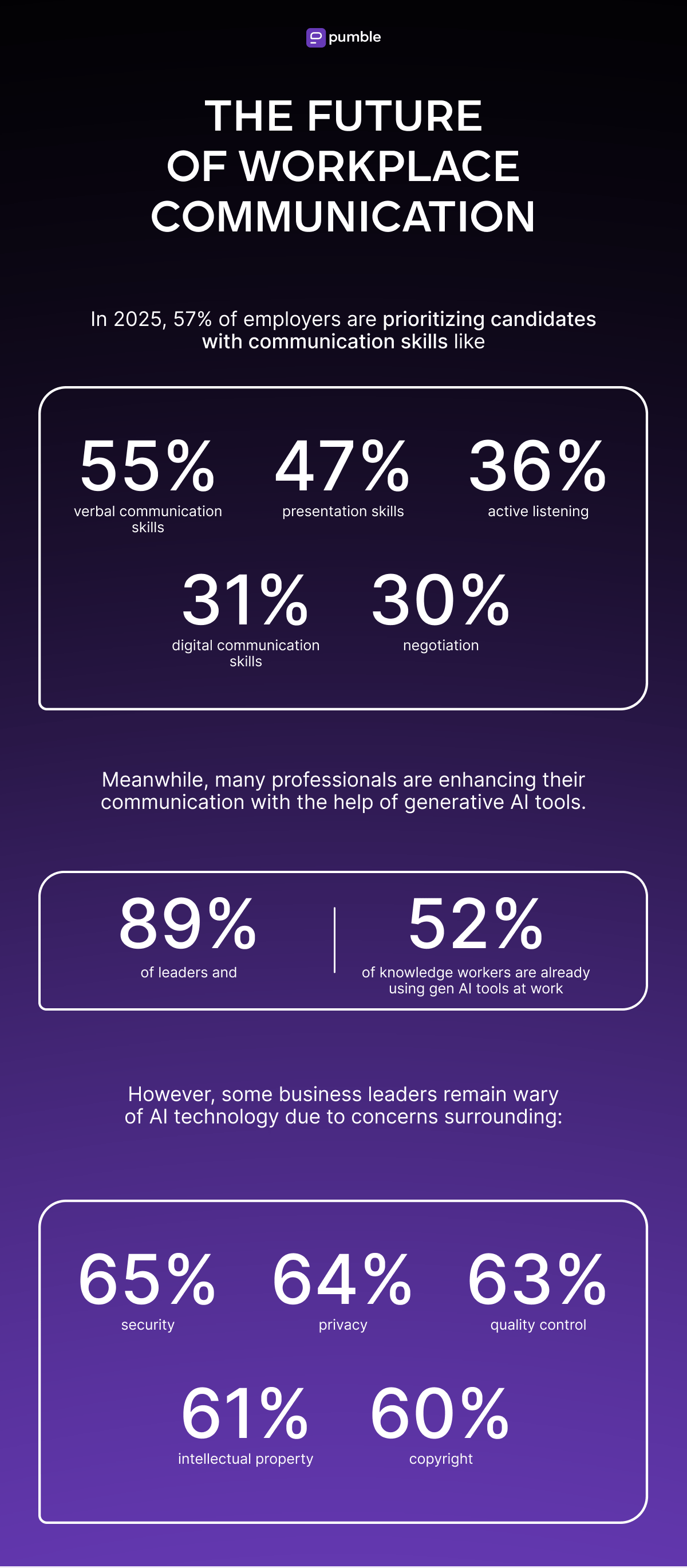
Statistics on the communication platforms people use in the workplace
As previously noted, email remains the reigning champion in the category of platforms people use for business communication in 2025.
However, according to Communication Statistics 2025, online chat tools are still the second most popular platform for exchanging work-related communications.
| Internal communication | External communication | |
|---|---|---|
| 36% | 57% | |
| Online chat tools | 26% | 10% |
| Project management tools | 17% | 15% |
| Other | 9% | 6% |
| Phone calls | 6% | 9% |
| Face-to-face interactions | 6% | 2% |
The fact that meetings were last on this list makes sense, as 61% of survey respondents feel they waste time.
Then again, Grammarly’s most recent report paints a different picture in terms of the average hours workers spent communicating across various channels:
- Video, phone, and in-person meetings took up 10.45 hours of the average worker’s week,
- Email took up 5.94 hours per week,
- Text-based chat took up 3.89 hours,
- File-sharing documents took up 3.33 hours,
- Text messages took up 3.28 hours,
- Project management apps took up 2.46 hours,
- Whiteboards took up 1.81 hours, and
- Knowledge management tools took up 1.70 hours.
Whatever the case may be, the prevalence of emails in external communication makes sense when we consider that online messaging tools are usually used for internal communication only.
However, many messaging apps now have guest account options, which may increase their usage in communication with clients and external collaborators.
🎓 PUMBLE PRO TIP
Even though emails account for the lion’s share of all business communication, they’re not the ideal platform for those exchanges. Find out why here:
Statistics on workplace communication channels usage and effectiveness
The most recent State of the Sector report analyzed the various communication channels we may use in the workplace — as well as their effectiveness.
The following were 5 of the most used broadcast channels employers apply when they want to share information with the organization at large:
- Emails were used at a rate of 92%, and they were considered to be 89% effective,
- All-employee live events were used 78% of the time with an effectiveness of 97%,
- E-newsletters were used 71% of the time with an effectiveness of 87%,
- Leader live events were used 63% of the time with an effectiveness of 98%, and
- Videos were used 59% of the time with an effectiveness of 85%.
As for the other broadcast channels listed in the report, leader and all-employee conference calls were also shown to have an effectiveness of over 96%.
The most recent report from Axios HQ also featured a breakdown of channels used by employers for internal communications as well as the rate of employee preference for each solution.
Namely, leaders tend to gravitate towards:
- All-hands or department meetings (according to 36% of surveyed leaders),
- Employee apps (34%),
- Chat/IM tools (33%),
- Phone calls (33%),
- Ad hoc emails (32%),
- Text messages (30%),
- Video messages (27%),
- Newsletters/recurring updates (24%),
- Intranets (24%),
- Physical or digital signage (23%), and
- Podcasts (20%).
Of those, podcasts had the lowest approval rating among employees (4%), while meetings were the most preferred way of taking in internal communications (36%).
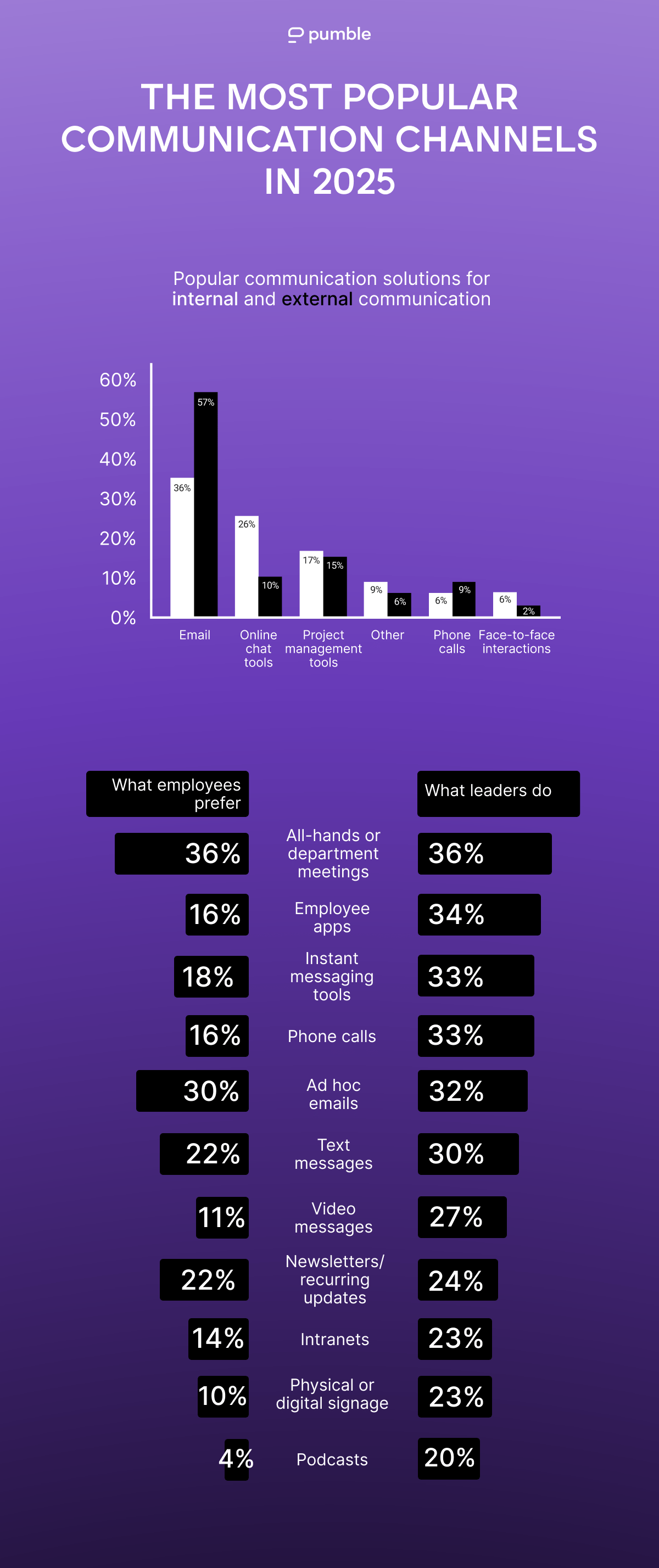
Improve your workplace communication outcomes with Pumble
As workplaces shift from offices to online environments, effective communication is becoming more important than ever — increasing the need for effective digital tools and proper training.
Yet, as we have learned from the State of the Sector 2024 report, a third of the survey respondents are dissatisfied with their workplace communication channels .
Even Grammarly’s most recent report shows that both business leaders and knowledge workers want better communication tools.
So, give the people what they want!
If your employees struggle to maintain effective internal or external communication — try the employee communication app, Pumble!
- Organize your conversations with direct messages, threads, and channels.
- Use roles and permissions to limit access to confidential information.
- Send voice and video messages or have video calls with the whole team — and have your clients join in by giving them guest access.
Make the most of your workplace communication.
How we reviewed this post: Our writers & editors monitor the posts and update them when new information becomes available, to keep them fresh and relevant.


